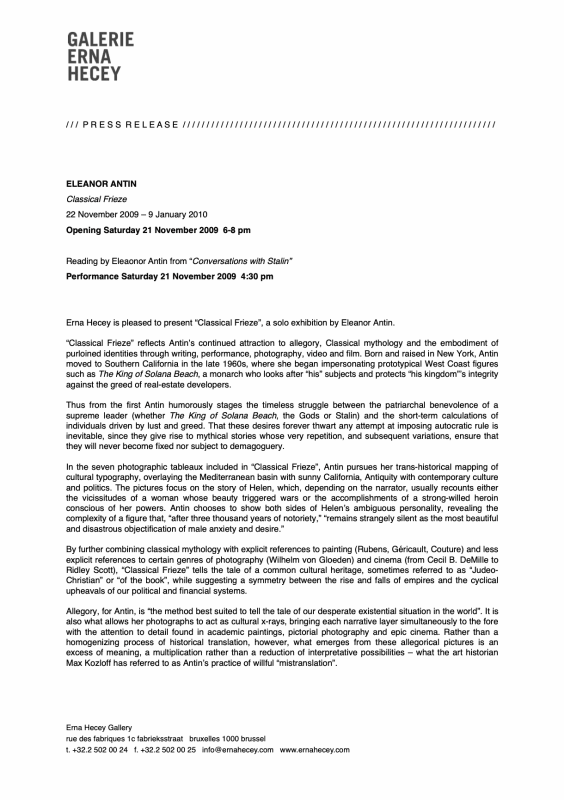Erna Hecey is pleased to present Classical Frieze, a solo exhibition by Eleanor Antin.
Classical Frieze reflects Antinʼs continued attraction to allegory, Classical mythology and the embodiment of purloined identities through writing, performance, photography, video and film. Born and raised in New York, Antin moved to Southern California in the late 1960s, where she began impersonating prototypical West Coast figures such as The King of Solana Beach, a monarch who looks after “his” subjects and protects “his kingdom”ʼs integrity against the greed of real-estate developers.
Thus from the first Antin humorously stages the timeless struggle between the patriarchal benevolence of a supreme leader (whether The King of Solana Beach, the Gods or Stalin) and the short-term calculations of individuals driven by lust and greed. That these desires forever thwart any attempt at imposing autocratic rule is inevitable, since they give rise to mythical stories whose very repetition, and subsequent variations, ensure that they will never become fixed nor subject to demagoguery.
In the seven photographic tableaux included in Classical Frieze, Antin pursues her trans-historical mapping of cultural typography, overlaying the Mediterranean basin with sunny California, Antiquity with contemporary culture and politics. The pictures focus on the story of Helen, which, depending on the narrator, usually recounts either the vicissitudes of a woman whose beauty triggered wars or the accomplishments of a strong-willed heroin conscious of her powers. Antin chooses to show both sides of Helenʼs ambiguous personality, revealing the complexity of a figure that, “after three thousand years of notoriety,” “remains strangely silent as the most beautiful and disastrous objectification of male anxiety and desire.”
By further combining classical mythology with explicit references to painting (Rubens, Géricault, Couture) and less explicit references to certain genres of photography (Wilhelm von Gloeden) and cinema (from Cecil B. DeMille to Ridley Scott), Classical Frieze tells the tale of a common cultural heritage, sometimes referred to as “Judeo- Christian” or “of the book”, while suggesting a symmetry between the rise and falls of empires and the cyclical upheavals of our political and financial systems.
Allegory, for Antin, is “the method best suited to tell the tale of our desperate existential situation in the world”. It is also what allows her photographs to act as cultural x-rays, bringing each narrative layer simultaneously to the fore with the attention to detail found in academic paintings, pictorial photography and epic cinema. Rather than a homogenizing process of historical translation, however, what emerges from these allegorical pictures is an excess of meaning, a multiplication rather than a reduction of interpretative possibilities – what the art historian Max Kozloff has referred to as Antinʼs practice of willful “mistranslation”.
In Constructing Helen (2007), Antin catches myth-making in the act, so to speak: men are busy at work on a sculpture of a supine naked woman, her larger-than-life size reducing them to Lilliputian dimensions. If a model is to be selected, one woman must be able to stand out from her rivals. Hence in Casting Call and Judgment of Paris, both from 2007, Antin derides the age-old trope of a male jury deciding the fate of female candidates (a trope that endures in so-called “reality” TV shows like The Apprentice). Whereas painters have often achieved spectacular visual effect by representing the decapitation of men – that is, by capitalising on the viewerʼs assumed castration anxiety – in Helenʼs Vengeance (2007) three inebriated Fates, a little girl and Helen herself revel in the spectacle of the poetʼs bloodied head, while in the background the painter vainly attempts to free himself from a bird cage. Proserpine Welcomes Helen (2007) captures another “imaginary” moment in the life of Helen. Proserpine, or Persephone in the Greek tradition, offers Helen a warm welcome to the underworld where she dwells as Hadesʼ consort – an encounter none of the great poets describe, but which Antin faithfully restages for the camera. Plaisir dʼAmour (2007), based on Thomas Coutureʼs 1847 painting Decadence of the Romans, now in the Musée dʼOrsay, depicts yet another censored scene from Helenʼs official biography, when her relationship with Paris has lost its initial spark: here she is seen reluctantly taking part in an apathetic orgy, while the Greek army takes decades to carry out its siege of Troy. The Tourists (2007) pushes the allegorical blend of references further still, mixing the pathos of Géricaultʼs The Raft of the Medusa with two Helens on their way to the mall, dressed like stars in a classical prequel of The Devil Wears Prada.
As ambiguous as Helenʼs personality, Antinʼs carefully choreographed images draw upon two apparently mutually exclusive registers: the impression of temporal and narrative seamlessness induced by the filmʼs movement at 24 frames per second, and the truth-effect produced by the photographʼs split-second shutter speed. Between the formerʼs story-telling and the latterʼs assumed role as objective witness, Antin creates medium hermaphrodites, at once fictional and truthful, immediate and slow. As evidence of Antinʼs long-standing interest in this temporal convergence, Classical Frieze includes a short film by Antin, also entitled Classical Frieze, that reveals the similarity between the artistʼs technique for shooting still photographs and the shooting of Hollywood movies.
For the opening of Classical Frieze at Erna Hecey, Antin will read from her “memoir” entitled Conversations with Stalin, a text that switches between “absurdist comic confession and ironical pathos.” As yet another incarnation of Antinʼs complex life and thought, Conversations with Stalin plays with heterogeneous narrative registers and biographies – specifically, in this case, upon the artistʼs own experience of growing up in 1950s America in a Jewish, Communist, Eastern European immigrant household.
A cabinet presentation of drawings related to Conversations with Stalin will complete the exhibition. Classical Frieze is the third solo exhibition at Erna Hecey Gallery, Brussels, following 100 Boots in 2006 and The Empire of Signs in 2007.

